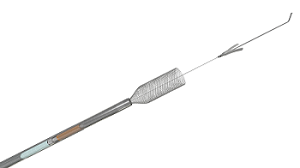
Interventional neurologists at McLaren Macomb have successfully performed Macomb County's first Pipeline Flex embolization, a minimally invasive neurological procedure for the treatment of brain aneurysms.
A specialized stent, the Pipeline is implanted in the brain, diverting blood flow (embolization), preventing the aneurysm from growing and allowing it to heal.
An aneurysm is a thinning and weakening the arterial wall, creating a balloon-like bulge. Blood flow aids in the growth of the aneurysm, which increases the chances of rupture, sending blood into the brain and skull. A ruptured aneurysm causes a subarachnoid hemorrhage, a severely life-threatening condition.
"It is critically important to divert continuous blood flow into the aneurysm," said Dr. Aniel Majjhoo, medical director of the McLaren Macomb Neurosciences Institute and the interventional neurologist who performed the procedure. "And when faced with the aneurysm, this is a favorable, minimally invasive and effective treatment option we now have available."
Performed by interventional neurologists utilizing the latest imaging technology, a mesh-like metallic alloy stent is placed across the neck of the aneurysm in the cerebral artery. This is performed via a minimally invasive procedure - tunneling a catheter from an artery in the groin to an artery in the brain. After the stent is placed, the embolization will naturally shrink the aneurysm over time, decreasing the chances of rupture.
"Traditional treatment options would have the neurologist working within the aneurysm," said Dr. Majjhoo. "The delicate nature of the aneurysm makes flow diversion a favorable option."
The patient, a 25-year old female from Roseville, made an appointment with her family medicine physician complaining of frequent headaches. After diagnostic imaging testing, it was determined he had an aneurysm that had dangerously progressed, nearing rupture.
Dr. Majjhoo placed the Pipeline in her brain. Six months later the aneurysm was gone (confirmed by diagnostic imaging), along with the symptoms it had caused.

An estimated six million Americans live with an un-ruptured cerebral aneurysm with 30,000 cases rupturing each year. An extremely critical condition, ruptured aneurysms require immediate medical intervention and have a survival rate of 40 to 50 percent with a 20 percent chance of recovery without permanent physical defects. Traditional treatments have included surgical clipping and endovascular coiling. Both remain viable options as not all aneurysm patients are candidates for the Pipeline.
Un-ruptured aneurysms may not present with any symptoms while others will have symptoms of worsening headaches numbness on one side of the face, double vision and drooping eyelids. Ruptured aneurysm symptoms (requiring emergency medical care) include a sudden-onset severe headache described as the "˜worst headache ever,' nausea and vomiting, stiff neck, blurred and double vision, seizure, sensitivity to light, droopy eyelids, confusion and loss of consciousness.
The introduction of the Pipeline Flex embolization comes with approval by the US Food and Drug Administration after successful clinical trials.
To learn more about neurosciences at McLaren Macomb, visit mclaren.org/macombneurology.